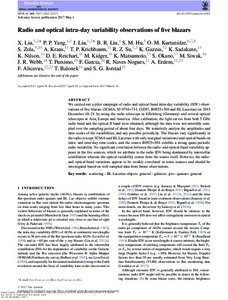Radio and optical intra-day variability observations of five blazars
Liu X; Yang PP; Liu J; Liu BR; Hu SM; Kurtanidze OM; Zola S; Kraus A; Krichbaum TP; Su RZ; Gazeas K; Sadakane K; Nilsson K; Reichart DE; Kidger M; Matsumoto K; Okano S; Siwak M; Webb JR; Pursimo T; Garcia F; Nogues RN; Erdem A; Alicavus F; Balonek T; Jorstad SG
Radio and optical intra-day variability observations of five blazars
Liu X
Yang PP
Liu J
Liu BR
Hu SM
Kurtanidze OM
Zola S
Kraus A
Krichbaum TP
Su RZ
Gazeas K
Sadakane K
Nilsson K
Reichart DE
Kidger M
Matsumoto K
Okano S
Siwak M
Webb JR
Pursimo T
Garcia F
Nogues RN
Erdem A
Alicavus F
Balonek T
Jorstad SG
OXFORD UNIV PRESS
Julkaisun pysyvä osoite on:
https://urn.fi/URN:NBN:fi-fe2021042717257
https://urn.fi/URN:NBN:fi-fe2021042717257
Tiivistelmä
We carried out a pilot campaign of radio and optical band intra-day variability (IDV) observations of five blazars (3C66A, S5 0716+714, OJ287, B0925+504 and BL Lacertae) on 2015 December 18-21 by using the radio telescope in Effelsberg (Germany) and several optical telescopes in Asia, Europe and America. After calibration, the light curves from both 5 GHz radio band and the optical R band were obtained, although the data were not smoothly sampled over the sampling period of about four days. We tentatively analyse the amplitudes and time-scales of the variabilities, and any possible periodicity. The blazars vary significantly in the radio (except 3C66A and BL Lacertae with only marginal variations) and optical bands on intra-and inter-day time-scales, and the source B0925+504 exhibits a strong quasi-periodic radio variability. No significant correlation between the radio-and optical-band variability appears in the five sources, which we attribute to the radio IDV being dominated by interstellar scintillation whereas the optical variability comes from the source itself. However, the radio and optical-band variations appear to be weakly correlated in some sources and should be investigated based on well-sampled data from future observations.
Kokoelmat
- Rinnakkaistallenteet [27094]
